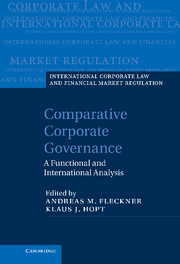23 - Brazil
New developments in corporate governance
from C - The Americas
Published online by Cambridge University Press: 05 July 2013
Summary
Introduction
In the past years, much has been discussed in Brazil about corporate governance. Due to the development of its capital market, the increase in the number of institutional investors looking for Brazilian companies to invest in, and the creation of different listing segments in its stock exchange, corporate governance has been a point of debate among shareholders, companies, regulatory agencies, and scholars.
Therefore, some self-regulatory rules have been created; the regulatory agency has been promulgating several rules in order to make the Companies Act in accordance with the best practices of corporate governance; and some institutions have created non-binding codes that are used as recommendations for the companies.
However, as this is a recent movement in the capital market, there are not yet many books that entirely cover the subject. Much of the debate among scholars is articulated through articles and presentations or speeches.
General information on corporate governance
Definition of corporate governance
Brazil does not have a legal definition for corporate governance. However, the Brazilian Institute of Corporate Governance (“IBGC”) defines corporate governance as a system in which companies are directed and monitored by shareholders, the board of directors, officers, independent auditors, and a board of auditors. Good practices of corporate governance aim to increase the value of the company, facilitate its access to capital, and contribute to its sustainability. This concept is used by the Brazilian Stock, Commodities, and Futures Exchanges (“BM&FBovespa”) to define the different listing segments of shares. In spite of not using the term “corporate governance,” the Corporations Act establishes the duties and liabilities for officers, directors, and controlling shareholders.
- Type
- Chapter
- Information
- Comparative Corporate GovernanceA Functional and International Analysis, pp. 1013 - 1041Publisher: Cambridge University PressPrint publication year: 2013

